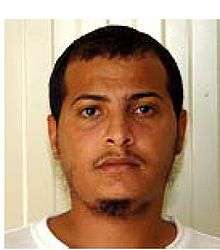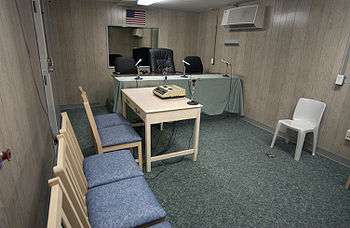Musab Omar Ali Al Mudwani
Musab Omar Ali al Madoonee is a citizen of Yemen who was held in extrajudicial detention in the United States Guantanamo Bay detainment camps, in Cuba.[1]
| Musab Omar Ali al Madoonee | |
|---|---|
 | |
| Born | c. 1980 Al-Hudida, Yemen |
| Arrested | 2002-09-11 Karachi Pakistani security officials, CIA |
| Detained at | Dark prison, Guantanamo |
| Alternate name | Musab Omar Ali al Mudwani Musab Omarali al Mudwani |
| ISN | 839 |
| Status | Transferred to Oman on January 16, 2017 |
Joint Task Force Guantanamo analysts estimate Al Madoonee was born in 1980, Al-Hudida, Yemen.
The United States Senate Intelligence Committee report on CIA torture listed Al Mudwani as one of the individual held in the CIA's secret network of black sites.[2] [2] Musab al Mudwani was apprehended by a combined force of Pakistani security officials and a CIA black site team, on September 11, 2002, the anniversary of al Qaeda's attack within the USA. He and five other individuals spent slightly more than a month in CIA custody at the salt pit, prior to being transferred to Guantanamo. Guantanamo analysts maintained the narrative that these six were an al Qaeda sleeper cell they called the "Karachi Six".[3][4][5] However, that claim had quietly been dropped by his 2016 Periodic Review Board hearing. Mudwani was transferred to Oman on January 16, 2017.[6]
Official status reviews
Originally, the Bush Presidency asserted that captives apprehended in the "war on terror" were not covered by the Geneva Conventions, and could be held indefinitely, without charge, and without an open and transparent review of the justifications for their detention.[7] In 2004, the United States Supreme Court ruled, in Rasul v. Bush, that Guantanamo captives were entitled to being informed of the allegations justifying their detention, and were entitled to try to refute them.
Office for the Administrative Review of Detained Enemy Combatants

Following the Supreme Court's ruling the Department of Defense set up the Office for the Administrative Review of Detained Enemy Combatants.[7][10]
Scholars at the Brookings Institution, lead by Benjamin Wittes, listed the captives still held in Guantanamo in December 2008, according to whether their detention was justified by certain common allegations:[11]
- Musab Omar Ali Al Mudwani was listed as one of the captives who "The military alleges ... are members of Al Qaeda."[11]
- Musab Omar Ali Al Mudwani was listed as one of the captives who "The military alleges ... traveled to Afghanistan for jihad."[11]
- Musab Omar Ali Al Mudwani was listed as one of the captives who "The military alleges that the following detainees stayed in Al Qaeda, Taliban or other guest- or safehouses."[11]
- Musab Omar Ali Al Mudwani was listed as one of the captives who "The military alleges ... took military or terrorist training in Afghanistan."[11]
- Musab Omar Ali Al Mudwani was listed as one of the captives who "The military alleges that the following detainees were captured under circumstances that strongly suggest belligerency."[11]
- Musab Omar Ali Al Mudwani was listed as one of the captives who was an "al Qaeda operative".[11]
- Musab Omar Ali Al Mudwani was listed as one of the captives who "deny affiliation with Al Qaeda or the Taliban yet admit facts that, under the broad authority the laws of war give armed parties to detain the enemy, offer the government ample legal justification for its detention decisions."[11]
- Musab Omar Ali Al Mudwani was listed as one of the captives who had admitted "fighting on behalf of Al Qaeda or the Taliban."[11]
Habeas Corpus petition
Al Mudwani had a writ of habeas corpus filed on his behalf.[12] Historian Andy Worthington reported that when his petition was finally considered in December 2009, it was turned down, even though he had been a "model prisoner".
References
-
OARDEC. "List of Individuals Detained by the Department of Defense at Guantanamo Bay, Cuba from January 2002 through May 15, 2006" (PDF). United States Department of Defense. Archived (PDF) from the original on 2007-09-30. Retrieved 2006-05-15.

- Swati Shara (2014-12-09). "List of the 119 prisoners detained in CIA's secret prisons program". Boston Globe. Archived from the original on 2014-12-13. Retrieved 2014-12-11.
-
Britain Eakin (2016-06-30). "Big-Brother Figure Makes Case for Gitmo Release". Courthouse News Service. Archived from the original on 2016-07-02. Retrieved 2016-07-06.
Though the United States initially suspected that the six were involved with an al-Qaida cell plotting a future attack, the case has failed to get off the ground for 14 years for lack of evidence. As documented in the detainee's unclassified profile, U.S. has tempered its claims about the Karachi 6 in recent years, describing them now as low-level al-Qaida fighters.
- Carol Rosenberg (2013-06-17). "List of 'indefinite detainees'". Miami Herald. Archived from the original on 2016-04-11. Retrieved 2016-08-18.
-
Carol Rosenberg (2013-06-17). "FOAI suit reveals Guantanamo's 'indefinite detainees'". Miami Herald. Archived from the original on 2014-11-21. Retrieved 2016-08-18.
The Miami Herald's Carol Rosenberg, with the assistance of the Media Freedom and Information Access Clinic at the Yale Law School, filed suit in federal court in Washington D.C., in March for the list under the Freedom of Information Act. The students, in collaboration with Washington attorney Jay Brown, represented Rosenberg in a lawsuit that specifically sought the names of the 46 surviving prisoners.
- http://www.miamiherald.com/news/nation-world/world/americas/guantanamo/article127055319.html
-
"U.S. military reviews 'enemy combatant' use". USA Today. 2007-10-11. Archived from the original on 2012-08-11.
Critics called it an overdue acknowledgment that the so-called Combatant Status Review Tribunals are unfairly geared toward labeling detainees the enemy, even when they pose little danger. Simply redoing the tribunals won't fix the problem, they said, because the system still allows coerced evidence and denies detainees legal representation.
- Guantánamo Prisoners Getting Their Day, but Hardly in Court, New York Times, November 11, 2004 - mirror Archived 2007-09-30 at the Wayback Machine
- Inside the Guantánamo Bay hearings: Barbarian "Justice" dispensed by KGB-style "military tribunals", Financial Times, December 11, 2004
- "Q&A: What next for Guantanamo prisoners?". BBC News. 2002-01-21. Archived from the original on 24 November 2008. Retrieved 2008-11-24.CS1 maint: BOT: original-url status unknown (link)
- Benjamin Wittes; Zaathira Wyne (2008-12-16). "The Current Detainee Population of Guantánamo: An Empirical Study" (PDF). The Brookings Institution. Archived (PDF) from the original on 2017-05-19. Retrieved 2010-02-16.
- Andy Worthington (2009-12-15). ""Model Prisoner" at Guantánamo, Tortured in the "Dark Prison," Loses Habeas Corpus Petition". Retrieved 2016-12-07.